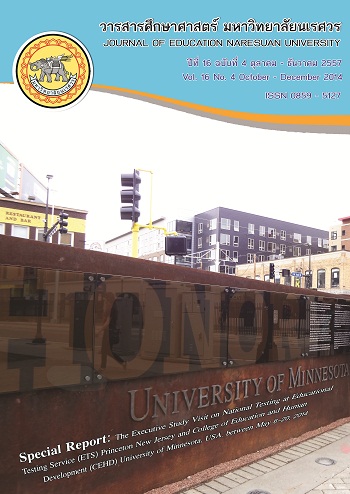กระบวนการพัฒนาเครื่องมือการประเมินผลการปฏิบัติวิชาชีพของครูผู้ช่วย
Main Article Content
Abstract
บทคัดย่อ
ตามพระราชบัญญัติระเบียบข้าราชการครูและบุคลากรทางการศึกษา พ.ศ. 2546 มาตรา 56 กำหนดให้ครูผู้ช่วยรับการประเมินในช่วงเวลาเตรียมความพร้อมและพัฒนาอย่างเข้มทุก 3 เดือน เป็นเวลาทั้งสิ้น 2 ปี ตลอดระยะเวลาในการประเมินผลการปฏิบัติวิชาชีพของครูผู้ช่วยที่ผ่านมา พบปัญหา คือ ครูผู้ช่วยไม่รู้วิธีในการเตรียมรับการประเมิน และผู้ประเมินขาดเครื่องมือที่ชัดเจนเพื่อใช้ในการประเมิน ดังนั้น เพื่อแก้ปัญหาที่เกิดขึ้น การวิจัยครั้งนี้จึงมีวัตถุประสงค์เพื่อสร้างเครื่องมือการเก็บและประเมินผลการปฏิบัติวิชาชีพของครูผู้ช่วย เพื่อดำเนินการตามคู่มือการเก็บและประเมินผลการปฏิบัติวิชาชีพของครูผู้ช่วยที่สร้างขึ้น และเพื่อประเมินผลการดำเนินการตามคู่มือการเก็บและประเมินผลการปฏิบัติวิชาชีพของครูผู้ช่วยที่สร้างขึ้น
ผลการวิจัยพบว่า
1. เครื่องมือการเก็บผลการปฏิบัติวิชาชีพ ประกอบด้วย แฟ้มสะสมผลการปฏิบัติวิชาชีพและคู่มือการเก็บผลการปฏิบัติวิชาชีพ และเครื่องมือการประเมินผลการปฏิบัติวิชาชีพ ประกอบด้วย แบบและเกณฑ์การประเมินผลการปฏิบัติวิชาชีพ และคู่มือการประเมินผลการปฏิบัติวิชาชีพ โดยทั้งเครื่องมือการเก็บและการประเมินผลการปฏิบัติวิชาชีพของครูผู้ช่วย ได้ผ่านการประเมินจากผู้เชี่ยวชาญ
2. ผลการประเมินผลการปฏิบัติวิชาชีพของครูผู้ช่วยโดยผู้ประเมินจำนวน15 คน แบ่งเป็น 3 กลุ่ม กลุ่มละ 5 คน ดำเนินการประเมินแฟ้มสะสมผลการปฏิบัติวิชาชีพของครูผู้ช่วย ซึ่งอยู่ในช่วงรับการประเมินตามเกณฑ์การประเมินครั้งที่ 1-4 และ ครั้งที่ 5-8 อย่างละ 1 แฟ้ม ผลการประเมินจากผู้ประเมินทั้ง 3 กลุ่มในภาพรวมมีความสอดคล้องไม่น้อยกว่า 4 ใน 5 คน ในรายด้าน พบว่า หมวดที่ 1 การปฏิบัติตน ผู้ประเมิน 4 ใน 4 คน มีผลการประเมินในภาพรวม และรายข้อสอดคล้องกันทุกกลุ่ม หมวดที่ 2 การปฏิบัติงาน ผู้ประเมิน 4 ใน 5 คน มีผลการประเมินในภาพรวมมีความสอดคล้องกัน เมื่อพิจารณาเป็นรายข้อ พบว่า ผู้ประเมิน 4 ใน 5 คน มีผลการประเมินสอดคล้องกัน 11 ข้อ ไม่สอดคล้องกัน 5 ข้อ ได้แก่ ตัวบ่งชี้ด้านการพัฒนาทักษะชีวิต สุขภาพกายและสุขภาพจิตของผู้เรียน ด้านการปลูกฝังวินัยและความเป็นประชาธิปไตยให้ผู้เรียน ด้านการจัดระบบดูแลช่วยเหลือผู้เรียน ด้านการใช้และสร้างเครือข่ายทางวิชาการ และด้านการศึกษาเกี่ยวกับชุมชน และผลการประเมินผลการปฏิบัติวิชาชีพของครูผู้ช่วย สำหรับเกณฑ์การประเมิน ครั้งที่ 5-8 พบว่า ผู้ประเมินทั้ง 3 กลุ่ม ในภาพรวมมีความสอดคล้องไม่น้อยกว่า 4 ใน 5 คน ในรายด้าน พบว่า หมวดที่ 1 การปฏิบัติตน ผู้ประเมิน 4 ใน 5 คน มีผลการประเมินในภาพรวม และรายข้อสอดคล้องกันทุกกลุ่ม ส่วนผลการประเมินในหมวดที่ 2 การปฏิบัติงานผู้ประเมิน 4 ใน 5 คน มีผลการประเมินในภาพรวมมีความสอดคล้องกัน เมื่อพิจารณาเป็นรายข้อ พบว่า ผู้ประเมิน 4 ใน 5 คน มีผลการประเมินสอดคล้องกัน 17 ข้อ ไม่สอดคล้องกัน 4 ข้อ ได้แก่ ตัวบ่งชี้ด้านการพัฒนาทักษะชีวิต สุขภาพกายและสุขภาพจิตของผู้เรียน ด้านการพัฒนาผู้เรียนที่มีความต้องการพิเศษ ด้านการพัฒนาและใช้แหล่งเรียนรู้และภูมิปัญญาท้องถิ่น และด้านการแลกเปลี่ยนเรียนรู้กับชุมชน
3. ผลการประเมินความพึงพอใจของครูผู้ช่วยต่อเครื่องมือเก็บผลการปฏิบัติวิชาชีพ พบว่า ครูผู้ช่วยมีความพึงพอใจในภาพรวม รายด้าน และรายข้อ อยู่ในระดับมากที่สุด ( อยู่ระหว่าง 4.67-4.98) และผลการประเมินความพึงพอใจของผู้ประเมินต่อเครื่องมือประเมินผลการปฏิบัติวิชาชีพ พบว่า ผู้ประเมินมีความพึงพอใจในภาพรวม รายด้าน และรายข้อ อยู่ในระดับมากที่สุด (
อยู่ระหว่าง 4.82-4.98) เช่นกัน
คำสำคัญ : การประเมินผล/ การปฏิบัติวิชาชีพ/ ครูผู้ช่วย
Abstract
According to Government Teacher and Educational Personnel Act B. E. 2546 section 56, new teachers’ professional performance are required to be strictly assessed every 3 months for 2 years. The past assessments indicated that those teachers did not know how to prepare themselves for such assessment and the assessors themselves did not have appropriate tools to do their job. The purpose of this study was to develop tools for assessing assistant teachers’ professional performance to solve the mentioned problem.
The methodology and the findings were as follows:
1. The constructed tools for collecting new teachers’ professional performance data consisted of a portfolio, and a tool manual while those for assessing new teachers’ professional performance comprised a form, criteria and a tool manual all of which had already been evaluated by experts before use.
2. The assessors were divided into three groups of 5 people. The teachers’ performance data collected in the two port folios; one for round 1-4 assessment and another for round 5-8, were assessed. The round 1-4 assessment made by 3 groups of assessors yielded similar results as a whole. At least 4 out of 5 assessors in each group expressed their opinion in the same direction. Due to the by-aspects assessment, it was found that 4 out of 5 assessors rated both sections similarly; the first related to the teachers’ behavior while the second to their performance. As for the by-items assessment, the study indicated that most items were rated similarly except 5 items for the indicators related to life skill development, learners’ physical and mental health, discipline and democracy implantation, provision of help for learners, academic network usage and creation, and community education. For round 5-8 assessment, the results obtained from 4 out of 5 assessors in all groups, as a whole and by-aspects, were similar. The by-items evaluation also yielded the same results except 4 items for the indicators related to life skill development, learners’ physical and mental health, development of children with special needs, development and usage of learning resources and local wisdom, and learning exchange in community.
3. Regarding satisfaction with the tools, it was found that the new teachers were satisfied at a highest level with all tools for collecting data ( between 4.67-4.98) and assessing professional performance, as a whole, by-aspects, and by-items (
between 4.82-4.98).
Keywords : Assessment/ Professional Performance/ New Teacher
Article Details
The owner of the article does not copy or violate any of its copyright. If any copyright infringement occurs or prosecution, in any case, the Editorial Board is not involved in all the rights to the owner of the article to be performed.


